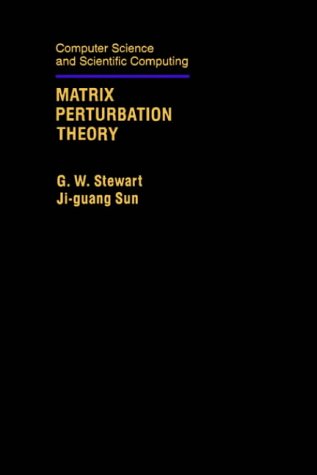Matrix perturbation theory pdf free
Par smith jeremy le jeudi, juin 18 2015, 22:31 - Lien permanent
Matrix perturbation theory by G. W. Stewart, Ji-guang Sun


Matrix perturbation theory G. W. Stewart, Ji-guang Sun ebook
Format: djvu
Publisher: Academic Press
Page: 376
ISBN: 0126702306, 9780126702309
Macroscopic quantum beats in a molecular magnet loosely fastened to the matrix. Key words: Mesoscopic and Nanoscale Systems. The observation that in perturbation theory the Stückelberg-Bogoliubov-Epstein-Glaser local S-matrices yield a local net of observables was first made in. The vector {x} then corresponds to a coloring of the elements and the discrepancy measures how balanced all of the sets are. The GKV Y - system promises to have other applications as well, especially within the intermediate region, λ ∼ 1 , where neither perturbation theory nor string theory are particularly useful. In one dimension, it is a member of a large universality class containing directed random polymers, stochastic Hamilton-Jacobi-Bellman equations, stochastically perturbed reaction-diffusion equations, stochastic Burgers equations and interacting particle models. Department of Physics, Sejong University, 143747 Employing the rotating wave approximation and perturbation theory, we compute the magnetization dynamics generated by ultrasound and discuss optimal conditions under which this novel quantum effect can be observed in a rotating single-molecule magnet. Nevertheless, the definition above, . Andrew Gelman adds his insights to this New Scientist cover article by Mark Buchanan on random matrix theory. It is shown that the elements of this matrix can be calculated, by a consistent use of perturbation theory, to any desired order in the fine-structure constant. Matrix {A} corresponds to a set system with elements corresponding to columns and sets corresponding to rows. The scattering of the magnons off of one another is encoded in a momentum-dependent phase, called the S matrix, that appears in the wave function for a two-magnon state. Since the wave function must satisfy the condition that . The basic algorithm of degenerate perturbation theory is quite simple: 1.Write the perturbed Hamiltonian as a matrix in the degenerate subspace. The class is characterized by the unusual dynamic The distributions, surprisingly, turned out to be those recently discovered in random matrix theory.
Jakobiec's Principles & Practice of Ophthalmology, Volume 2 ebook download
Secrets of the Demon (Kara Gillian, Book 3) book